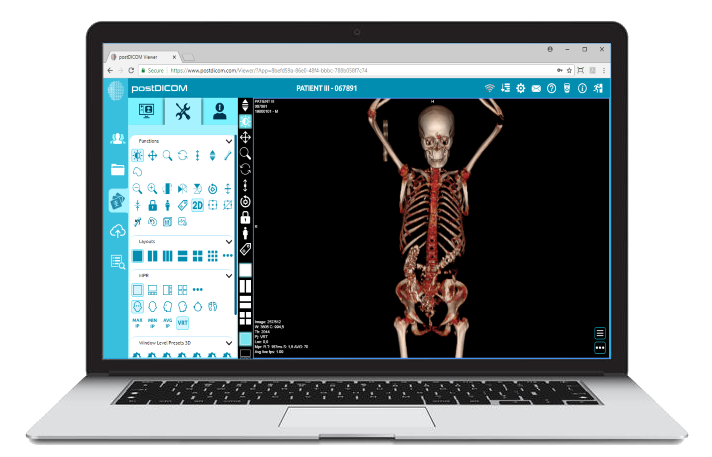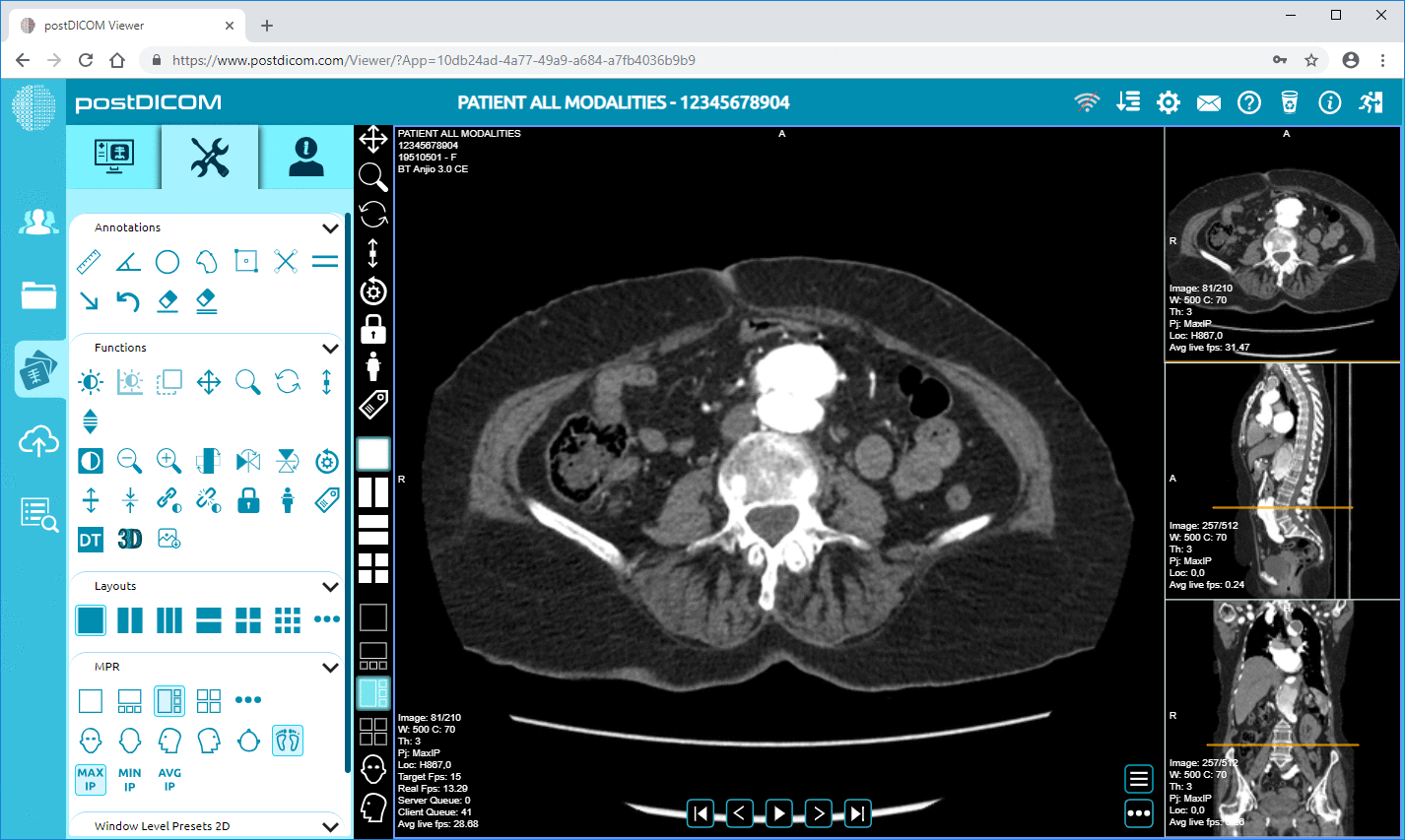
The diagnostic process alongside patient treatment within healthcare advances relies heavily on medical imaging techniques. The ability to capture, store, and share medical images of high quality remains crucial for all medical imaging professionals at hospitals, as well as students and healthcare providers.
Medical image sharing relies on the Digital Imaging and Communications in Medicine (DICOM) standard as its foundation. DICOM functions as a global medical imaging standard that allows diverse medical systems and devices to access and share images effortlessly.
This blog demonstrates the essential nature of DICOM standards in radiology practice and explains how these standards support imaging device interoperability. It shows PostDICOM's use of this standard to provide cloud storage solutions and AI-assisted diagnostic capabilities.
The DICOM standard was first introduced in the 1980s by the American College of Radiology (ACR) and the National Electrical Manufacturers Association (NEMA). The healthcare industry developed DICOM to solve the inconsistent medical imaging formats so that healthcare providers could manage image storage and transfer among different systems.
DICOM is both a file format and a communication protocol. As a file format, it ensures that medical images are stored in a universally compatible format, making it easy to view and interpret images regardless of the device or system used. The communication protocol of DICOM enables image transfer between multiple imaging devices to support smooth relationships between healthcare providers and their institutions.
The DICOM standard also enables universal access to medical images. The DICOM standard makes medical images accessible across different machines and systems, which enables enhanced clinical collaboration and better patient treatments between radiologists at hospitals, students, and doctors who provide remote consultations.
Medical imaging often produces large volumes of data. Storing these images in a structured and easily accessible format is crucial for healthcare providers. DICOM enables the creation of structured DICOM archives, ensuring that images are not only stored securely but can also be retrieved quickly and efficiently. These archives are crucial for long-term storage, enabling healthcare providers to access historical medical images for comparison and follow-up care.
One of the most significant challenges in medical imaging is the integration of different imaging devices and systems. DICOM addresses this challenge by ensuring that all devices—MRI machines, CT scanners, ultrasound devices, or X-ray systems—can communicate. This interoperability ensures that images captured on one device can be transferred and viewed on another without losing quality or compatibility issues.
Viewing medical images is a crucial aspect of diagnosing patients. PostDICOM’s diagnostic DICOM viewer enhances radiologists' efficiency by providing an intuitive and feature-rich tool for interpreting images. With support for advanced visualization techniques, radiologists can zoom in, adjust brightness, and enhance the image quality for accurate diagnosis. This ability to interact with images efficiently is pivotal in delivering timely and accurate medical decisions.
Today’s healthcare environment is more interconnected than ever. In the past, sharing medical images often meant physical copies, which were cumbersome and time-consuming. DICOM enables secure cloud-based sharing of medical images, allowing radiologists, physicians, and specialists to consult on cases remotely. This sharing capability is particularly valuable for second opinions, enabling healthcare providers to collaborate on complex cases even if they are located in different parts of the world.
Early Days: In the early days of medical imaging, Picture Archiving and Communication Systems (PACS) were used to store medical images locally. These systems were often costly and required significant infrastructure, limiting their accessibility and scalability. Additionally, the data could be vulnerable to security breaches or data loss due to hardware failure.
The Shift to Web-Based PACS: With the advent of the Internet, healthcare institutions began transitioning to web-based PACS systems. These systems allowed images to be accessed remotely, improving accessibility for medical professionals. However, this shift brought about new challenges in terms of security. Protecting sensitive medical data from cyber threats has become an ongoing concern.
The Cloud Revolution: The advent of cloud computing has revolutionized the storage and sharing of medical images. PostDICOM’s cloud-based PACS eliminates the limitations of traditional local storage systems by providing a flexible, scalable, and secure solution. Cloud storage allows healthcare providers to store vast amounts of data without the need for expensive on-site infrastructure. More importantly, it enables remote access, ensuring that medical professionals can access and share images from anywhere in the world.
Security is a critical concern in medical imaging, given the sensitive nature of the data involved. Medical images often contain personal patient information, making them prime targets for cyberattacks. Ensuring the security and integrity of these images is crucial for maintaining trust and complying with regulations.
DICOM encryption & compliance standards are designed to protect patient data. The standard supports encryption techniques that ensure images are securely stored and transmitted. Furthermore, DICOM complies with HIPAA (Health Insurance Portability and Accountability Act) in the United States, ensuring that patient data is protected according to stringent privacy standards. Internationally, DICOM also adheres to the General Data Protection Regulation (GDPR), which mandates strict data protection practices.
As telemedicine expands, DICOM plays a pivotal role in enabling remote consultations. Doctors and specialists can now conduct real-time consultations by sharing DICOM images through secure cloud platforms, facilitating faster diagnosis and better patient outcomes. This is particularly beneficial in underserved regions, where access to specialists may be limited.
PostDICOM’s secure image-sharing features make it easier for healthcare providers to collaborate on patient cases regardless of their geographical location. This remote sharing capability enables healthcare professionals to offer second opinions in real-time, which can be a life-saving tool in critical situations.
The impact of DICOM in telemedicine is especially significant in rural healthcare, where patients may not have access to the same level of healthcare facilities or specialists. DICOM cloud solutions bridge this gap by enabling healthcare providers to collaborate remotely and deliver quality care, regardless of location.
 - Created by PostDICOM.jpg)
PostDICOM represents the future of DICOM-based medical imaging. The platform offers a cloud PACS solution that integrates DICOM support without expensive hardware. This game-changer for healthcare institutions eliminates the high upfront costs and ongoing maintenance expenses associated with traditional PACS systems.
PostDICOM’s seamless DICOM image-sharing capabilities also support telemedicine, medical education, and research. By enabling the secure sharing of medical images, PostDICOM facilitates remote collaborations, improving patient care and enhancing educational opportunities for medical students and professionals.
In addition, PostDICOM harnesses the power of AI-driven diagnostics, enabling faster and more accurate interpretations of medical images. AI-powered tools can help radiologists identify patterns in medical images that might otherwise go unnoticed, improving the speed and accuracy of diagnoses.
The DICOM standard has revolutionized the way we handle medical imaging. DICOM has become the backbone of modern radiology and telemedicine by ensuring interoperability, compatibility, and security. PostDICOM takes this further by leveraging cloud technology and AI-driven tools to offer secure, efficient, and scalable solutions for medical image storage and sharing.
If you're looking for a reliable and secure way to manage your medical images, PostDICOM is the future of medical imaging. With its cloud-based PACS, seamless sharing features, and AI-powered diagnostic tools, PostDICOM helps healthcare providers deliver better care faster. Click here to sign up for a free trial!


|
Cloud PACS and Online DICOM ViewerUpload DICOM images and clinical documents to PostDICOM servers. Store, view, collaborate, and share your medical imaging files. |